|
Identifying Antique and Vintage Fashions: Use Your Eyes
by Barbara Johnson, Ph.D.
Posted
January
2010
|
 |
Collecting antiques is a compelling way to make history
come alive. Material objects have the power to easily transport
our imaginations back to earlier times. Collecting antique and
vintage clothing, hats and accessories is a special passion. More
than any other antique or collectible, fashions create feelings
of nostalgia and romanticism. Antique and vintage fashions
epitomize many faces of beauty, style and grace. Traveling
through different decades, collectors will fall in love again and
again with each unique offering. Clothing has always affected
many aspects of our cultural lives. Knowing how to date antique
and vintage clothing is also very helpful in dating heirloom
photographs down to a year. This is vitally important not only
for the photograph collector, but it also provides vital knowledge
for genealogists to help define our family histories.
The greatest challenge to maintaining a fashion
collection is to accurately identify and date your items. I like
to reduce identifying fashion articles down to a simple premise:
fashion has always been dictated by fads. These unique features in
dress went in and out very quickly. Identifying your collection’s
fads will easily date your clothing, hats and accessories down to
a year. Savvy collectors can become historical fashion experts in
no time if they study key details including fabrics, collars, cuffs,
colors, silhouettes and embellishments. Cavalier-style sleeve
cuffs (Photo 1) show military-style fashions that were popular
from the late 1870s to the early 1880s. It’s all about the details.
Scoping out new treasures while shopping requires
careful study before you go. Sleeve silhouettes provide age
clues. Certain examples were unmistakably worn during specific
years. The leg o’mutton sleeve changes yearly through the 1890s,
varying in the size and shape of the upper puffed and lower, tight
sleeve (Photos 2, 3 and 4). The 1930s offered a bevy of puffs,
cape sleeves, push-up varieties and ruffles which went in and
out of fashion and thus help date the garment. As for necklines,
the distinctive shapes of the 1830s and 1840s are romantic and
sloping. Sweetheart necklines of the late 1930s and early 1940s
remind us romance was not dead even though the world was
ravaged by war and deprivation. The 1950’s shelf bust necklines
are uniquely distinctive.
Silhouettes are another important method for dating
fashions as they underwent many distinctive changes through the
20th Century. Early 19th Century clothing starts with a slim line
and widens by the middle of the century. Victorian dress trains
went in and out of fashion depending on social codes and if the
garment was for day, evening or special occasion wear. The
Victorian bustle exhibits design changes for easy identification,
once you know the differences. The bustle transformed from an
elaborately shirred and protruding feature to a simpler, minorsized
puff. The 19th Century hourglass figure is obviously
recognizable. Let us not forget the slinky and sinuous bias-cut
silhouette of the 1930s or the peplums of the 1940s (Photo 5). The unmistakable mini skirt of the 1960s and 1970’s bell bottoms are all too familiar because many of us wore them.
Embellishments, fabrics and colors are wonderfully
easy ways to date items. Traveling through the 19th Century,
collectors will discover painted and embroidered purses, aprons
and parasols mirror similar embellishments on rare Victorian
painted or embroidered clothing. Fringe was popular during
the 1850s and 1860s (Photo 6). Differences in sequins between
the 19th and 20th Centuries define the age of clothing and
hats. Soutache cording was a distinctive embellishment during
the 1910s (Photo 7) and 1940s. Rhinestones on 1950s dresses
coincide with rhinestones applied to hats from the same year.
The avid fashion collector must become a textile
expert of sorts. Knowing your fabrics—silks, velvets, organza,
organdy, rayon and faille—is very helpful to tighten down the
age of a piece. Collectors must train their eyes and know the
look and feel of various Victorian silk brocades, laces and trims.
Varieties of satin are evident in the silk satin gowns of the 19th
Century and the synthetic-based fabrics of the 1930s and 1940s.
Keep an eye on popular fashion colors and patterns as they
appear through the 19th and 20th Centuries. Know the muted
pastels, earth tones and abstract roller prints worn in the early
19th Century. Checked and tartan plaid silks were popular in the
1850s (Photo 8) and 1860s. Iridescent, jewel-toned taffetas of
the 1950s (Photo 9) are unforgettable. Look for whimsical prints
worn during the 1930s (Photo 10). Do not forget the wildly bold
color combinations in the 1960s. Different combinations of lime
green, bright yellow, hot pink or bold orange worn together can
date your garment down to a specific year.
Collectors can use similar tips to help identify hats
and accessories. Headgear in the early to mid-19th century is
easy to identify. The majority of popular headwear consisted of
woven straw, plain or drawn silk bonnets and fabric caps before
the middle of the 19th century. Middle-to-late Victorian and
Edwardian hats require diligent homework to study the millinery
varieties that were shaped to compliment the changing coiffures
of Victorian and Edwardian women. Wearing the hair pulled
up, down, or to the sides explains the shapes and varieties of
antique and vintage bonnets and hats that might stump puzzled
collectors.
The most fascinating and varied hats are those of the
late 1930s to early 1940s. Whether tilted or toy, cone-shaped,
turban, open crown cartwheel or pancake varieties, these hats
are distinctive to their time period and easy enough to place into
a decade. Collectors can be relieved that some hats are easy
to date to a specific decade. The small, close-to-the-head styled
hats appear in various familiar varieties during the 1950s. The
classic pillbox of the 1960s is not uncommon to recognize.
Before you go shopping, the wise collector will do his or
her homework based on accurate research to find more treasures.
Successfully building up a collection requires proper dating and
identification. Collectors must rely on the legitimate knowledge
acquired through study of fashion fads and features. They should
use their eyes and other senses to make first-hand inspections of
fashion articles. The result will enable you to undoubtedly scope
out terrific finds and wonderful bargains.
Online shoppers should ask as many questions as
possible regarding condition, fabrics, trims, interior construction, presence of hand or machine stitches,
closure methods such as hooks, snaps or
zippers and the presence of alterations to
ascertain the age and/or legitimacy of the
piece. A clear and thorough description
is crucial to evaluate before purchasing.
All these preparation methods avoid
confusion and unnecessarily paying for
something when you think it is one thing
then discover later you were incorrect.
Collecting antique and vintage
clothing, hats and accessories is a
fascinating hobby. No other activity
transports you so clearly into another
decade of our past. We all identify with
fashion as a means of self-expression.
Enthusiasts might imagine wearing
such finery back then or perhaps wear a
treasured piece even now. Collectors can
feel satisfied that they are finding oneof-
a-kind pieces of our common history
intending to preserve them for future
generations.
Accurate dating and identification is a
mandatory step before assessing the value
of your collection. Dating enables better
management and organization. Affixing a
year date to a garment allows a collector to
properly match it with a period correct hat
or accessory. Whether you collect or wear
vintage, perform historical reenactments,
preserve artifacts in a museum or design
costumes for cinema or theater, the
importance of properly identifying what
you have can’t be stressed too much. Trust
your memory, eyes and other senses. Do
your homework and become responsibly
active in discovering and taking care of
what you own. This is the best defense
a collector can have in a competitive
market. Proper knowledge gives you the
power to make key investment choices in
a piece of clothing that will be an asset to
your collection.
|
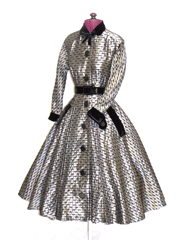
|
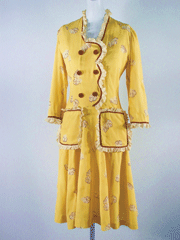
|
| Photo 9: Iridescent gray taffeta dress
with black velvet details and wide hip
pockets dating to the year 1950.
|
Photo 10: Adorable yellow day dress
dating to 1932 displays a whimsical print,
faux buttons and novelty hip pockets.
|
_________________________
About the Author: Barbara Johnson,
Ph.D. is a sixteenth-century British
cultural historian. She specializes in
the material objects of Elizabethan and
Jacobean aristocrats and their lives in
their country homes. She is the author of
Antique and Vintage Fashions, 1745-1979
by Collector Books, August, 2009 and
Valentines, A Collector’s Guide 1700s-
1950s, by Collector Books, 2010. Books
are available at www.collectorbooks.com,
in bookstores and online.
|
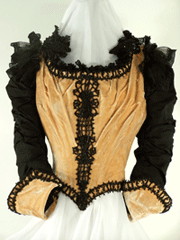
Photo 1: Apricot velvet, black taffeta and jet-trimmed
evening bodice with cavalier-style cuffs dating to 1883.
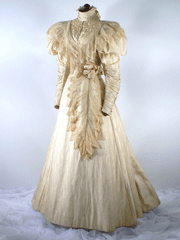
Photo 2: Elaborate ivory-patterned silk wedding gown
with lace, asymmetrical features and smocking dating
to 1896 due to the unmistakable shape of the sleeve.
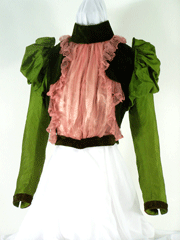
Photo 3: Remarkable 1897 bodice with characteristic
sleeves, pink satin topped with pink chiffon, and dark
green velvet accents contrasting against light green silk.
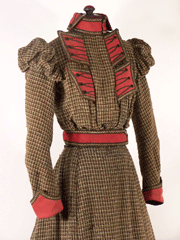
Photo 4: Checked wool day dress with unique sleeve
and high neckline dating to 1898.
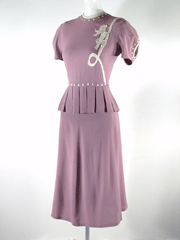
Photo 5: Lilac crepe dress with pleated
peplum and lace cupid climbing a
rope appliqué dating to 1946.
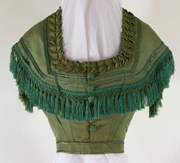
Photo 6: Green silk evening bodice
dating to 1863 illustrates the year’s
characteristic neckline, fringe, piping
and buttons.
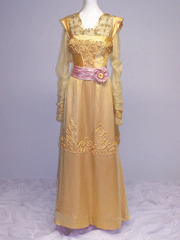
Photo 7: Golden yellow silk
satin gown
with gold metallic lace, contrasting
pink trim and soutache embellishments
dating to 1918.
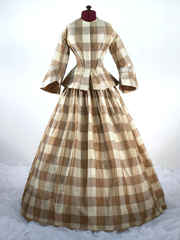
Photo 8: Brown and cream plaid silk
gown dating to 1857 displays bellshaped
sleeves and peplum.
|